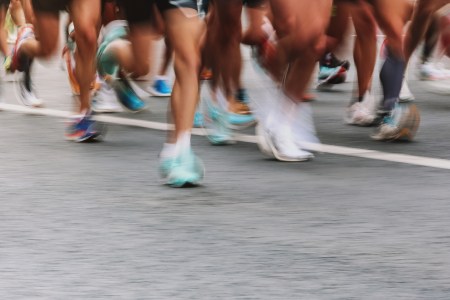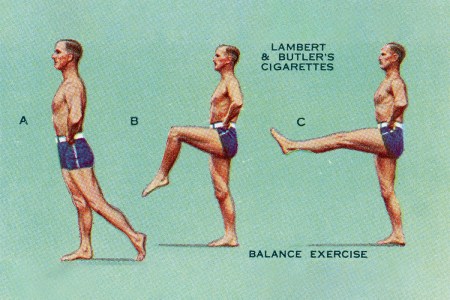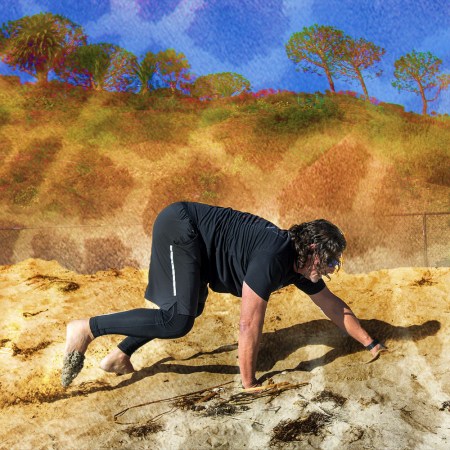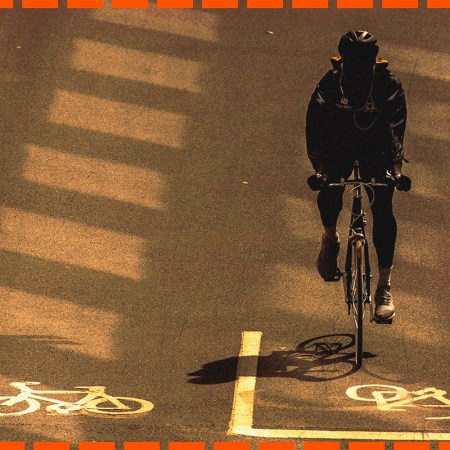A pair of hot takes, if you will: Fitness can be free, and fitness can be permanent.
Both may read as outlandish, or at least, at odds with today’s world of albatross subscriptions and tomorrow’s certainty of neuromuscular decline. It’s almost easier to envision personal fitness as something expensive and glorious in its transience. It asks a lot of your wallet and energy, apexes somewhere in your 20s, then exits stage left. Maybe you got a PR or a photo out of it.
But there’s another way, which starts with recalibrating your understanding of what being in shape should feel like (and look like). We’d argue that fitness has little to do with running marathons, and even less to do with taking your shirt off at the beach. It’s simply the freedom to move — to whatever degree your body will allow — over the course of one’s life.
When you strip fitness down to this level, it’s clear that you don’t need to do anything. You don’t need to try a spin class or take a cold plunge. You get to build up your version of “staying in shape,” pulling whatever levers are interesting to you, while observing a few tenets that are relevant to everyone.
This is where that first bullet comes back into play: the more that fitness becomes part of your rote, barebones identity — and less an unredeemed/guilt-trip expense on your credit card statement — the more “permanent” your wellness will become. Meanwhile, you’ll almost definitely spend less money on fitness in the process.
How do you pull that off, anyway? We volunteer five timeless precepts for lifelong strength and mobility, with an emphasis on routines that are accessible and affordable (if they cost anything at all).
A key point to remember: these are building blocks. Think of this guide as the wall surrounding your city, stymying the marauders and tornadoes conspiring to tear the whole thing down (travel plans, raising kids, unexpected sickness). Once you learn to embrace and appreciate these steps, the buildings within your city are of your own design. They can represent whatever it is you want to do with your fitness (running, pickleball, Muay Thai.) Life is long, fitness is fun, the sky’s the limit.
How to Prevent the Most Common Running Injuries
There are six of them. We explain how to train against each.1. Never stop walking
One of the greatest ways to drastically reduce one’s risk of all-cause and CVD mortality is also one of the easiest. Go for a walk. There’s a reason that wellness writers — including this one — dutifully cover seemingly common-sense studies (walking fast is good for the heart, walking in greenspace is good for the brain) ad nauseam.
It’s because walking is simply that effective. Getting into the habit was always a good idea, and doing so in an era as sedentary as this is almost revolutionary. We like how modifiable it is. Excuse the Seussian nature of this list, but think about it — there are lunch walks, catch-up walks with friends, digestive walks, run-walks, “microadventure walks” in new parks or cities, constitutional walks when you need a break from work, sunset walks.
The activity is receptive to your physical and psychological needs alike, which is rare in the personal fitness space. That makes it more of a companion than a boogeyman, and an excellent method for checking in oneself, while benefitting from the sheer act of movement. We implore you to make a daily walk (of any variety, in any weather), an unimpeachable element of your routine and personhood.
2. Honor the Zones
If staying in shape for you simply means a life of long walks, you’d be in good company. Look to amble-obsessed Japan, the nation with the highest concentration of centenarians…and a not-so-high percentage of gym memberships. (The average Japanese person now takes 6,500 steps a day; yet, in a Rakuten Insight survey, over half of Japanese responders, aged 20 to 60s, claimed that they “barely exercised.”)
The body does stand to benefit from dedicated exercise sessions, though. There’s no doubt about that. We just seem a little undecided about how long, intense and frequent they should be. This tends to lead to intimidation, or inaction, or both.
It helps to think of exercise (and specifically endurance training) in the context of heart rate zones. The majority of your training should ideally involve “lazy workouts,” or long stretches spent at 60-70% of your maximum heart rate. For four days a week, at around 45 minutes a session, you’ll want to move your body enough that your heart rate climbs into Zone 2. This might involve a well-paced walk, a light jog, a cycle over rolling hills, or even a cross-country ski.
In the world of running, this level of intensity is sometimes called “conversation pace.” It’s an apt phrase, as we also like to think of Zone 2 as a workout pace at which you could actually process and enjoy a podcast. Key word: enjoy. Done right (and regularly) hanging out in Zone 2 is a delight.
Since relaxed movement comprises the spine of your weekly movement, you’re only looking at one to two (depending on your fitness goals) sessions of more intense fare. Trips to Zones 4 and 5 — via a heart-pumping HIIT class, intervals at a local track, turns on an assault bike — should be sparing and intentional, lest you run the risk of overtraining or injury. That being said: upper-tier efforts a welcome chance to “lose oneself” in a challenge and an excellent bellwether of fitness progress.
These sessions can be extremely short, even 10 minutes or less. How’s that for a deal? You only have to push yourself to 80-90% of your maximum heart rate for less than 1% of your week.
A final plus: while getting accustomed to all of these numbers — and what it takes to dip in and out of them — may feel like the domain of “gung-ho” fitness types, HR wearables are as ubiquitous as ever. Without too much thought or effort, you can now better understand yourself and program that knowledge into your life. Make sure you’re linked up to the Health app on your phone.
To get you started, remember: your max HR is going to be right around 220 minus your age. Then multiply that accordingly, depending on your goals for the specific workout. The numbers will change as you age. That’s okay. Getting older doesn’t mean getting out of shape.
3. Prioritize bodyweight exercises
Of course: no matter how “permanent” your fitness is, muscle mass is objectively guaranteed to melt away. It decreases at a rate of up to 8% each decade over the age of 30, and that process only accelerates over the age of 60. The clinical term (sarcopenia) umbrellas a variety of aging hazards: strength loss, decreased bone density, joint stiffness, curvature of the spine, etc.
But if you make strength training a consistent component of your fitness regimen — even to the tune of just one or two sessions a week — you’ll fortify your muscles and bones for the long haul, while cashing in on all those short-term benefits you were angling for, anyway, like looking good in a fitted shirt.
What should those sessions look like? That’s up to you. You could get a gym membership and lift with the usual rack of weights, or get into “unconventional training tools” like maces, sleds and sand bags. For long-term fitness, though, we favor bodyweight movements. You might know them as calisthenics: push-ups, squats, pull-ups, lunges, parallel dips, burpees, etc. A few reasons we favor them:
- They do a lot with a little. One study (of trainees over 60!) found that calisthenics can increase power by 15% in just 10 months.
- They compel “functional” movements, which recruit a lot of muscles and simulate real-world pushes/pulls
- They’re easier on the joints
- They’re modifiable — you can make them easier or harder depending on your energy levels or the tenor of the workout
- And they’re also “portable.” It’s possible to perform calisthenics anywhere, at any time. Think about how destabilizing a week of travel can be…having a few bodyweight moves to lean on could be a difference-maker.
When programming a calisthenics workout, settle on six exercises or so. For each exercise, aim for three to five sets of at least 10 repetitions. Keep an open mind to exercises you haven’t tried yet, in order to keep things fresh (and mentally acknowledge that the one you always avoid is the one most likely to make you stronger).
15 Mobility Tests to Make Sure You’re Aging A-Okay
From trunk rotations to ankle flexes, these moves are quick, simple and free to try4. Shock yourself
While a mix of walks, Zone work and bodyweight training is a pretty potent recipe for permanent fitness, it’s essentially guaranteed that you will get bored by aspects of this routine. There are two ways to mortgage against this inevitability: (a) make it part of your identity (more on this in a second) and (b) shock yourself.
“Shocking yourself,” in exercise terms, could mean going for a big hike, trying an animal style workout, or taking a martial arts class. Think of them as fitness field trips; you open to the occasional new way to move and sweat, basically, while trusting that your larger, day-to-day fitness framework will be there when you get back. On the off chance you find you much prefer whatever exercise this is, then that’s great, too: you may have stumbled upon an autotelic activity. These are “flow state” candidates — the activities you genuinely enjoy, feel intrinsically motivated to do and love doing for their own sake.
In a study published three years ago, researchers from the United States and Spain found that when trainees opened themselves to new moves or exercise patterns, “they reported feeling much more motivated to exercise.” (The researchers called this “muscle confusion,” in which the term is used as a positive.)
Similar to Zone 4 or 5 efforts, these are opportunities to put your fitness to the test — or at the least, find out how all that diligent maintenance translates to a different concentration. They’re mental refreshes…disguised as physical challenges. As always, it’s important to recognize your limits and rest/recharge accordingly once the day is done.
5. Make it part of your identity
Still: automation is a good thing and boring is better than nothing. It’s possible to get to a point where you don’t think much about fitness (let alone stress about it) — you might just have to think a lot about it at the start, when you’re first getting going.
That’s because, for so many of us, permanent fitness requires a seismic initial shift in identity. You have to start telling yourself a different story about yourself. You are a person who goes for a walk after lunch. You do spend 180 minutes on a bike each week. As these mantras turn into facts, and slowly become entangled with your sense of self, it’ll get harder and harder for you to skip out on your healthiest habits.
Don’t be surprised, also, when this accumulation infects (in the most positive way!) other aspects of your life. You will fidget more, stretch more, sleep more. Exercise is self-propagating; even on rest days, your commitment to movement will find you out in the garden, at the ocean before dawn, or on a walk in the woods. The better you get at “it,” the less you’ll realize you’re doing it at all. And your mood, mobility and biomarkers will head in the right direction along the way.
Whether you’re looking to get into shape, or just get out of a funk, The Charge has got you covered. Sign up for our new wellness newsletter today.
























